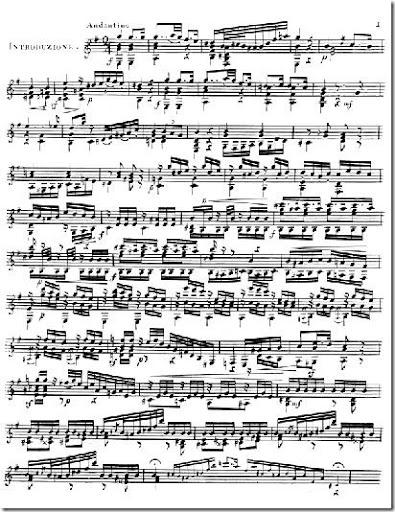Take a look at the following music sample. This is the first page of the first edition of Mauro Giuliani's Rossiniane Opus 119 Number 1. You've just sat down to find this impressive pile of ink on your music stand. Your eye barely travels half-way across the first line when panic strikes. Look at that rhythmic figure! My God! You feverishly start counting the beams... Sixty fourth notes! "I can't play that fast" you're thinking. Now, at this point if you are anything like I was, you start scanning down the page and see... Double-dotted notes, lots of funny looking patterns of rests and thirty second notes in the melody. You thank the Lord for the repeating bass figures, but your brain slowly begins to shut down as you spy some double sharps and embellishment notes on some additional thirty second note passages. You're jelly at this point. And that automatically makes you toast. Hmmm. Toast and jelly...
Way back when notation first took the world by storm and people began writing down music rather than just losing it for posterity via 'passing it on' by performance, others have striven to read the mess that composers left. Printers and editors have striven equally to ensure that music is as easy to read for the performer as possible. You don't believe that. You just know that someone somewhere has done his absolute best to make you look foolish when the sample above was arranged for print.
First off, realize that when you see lots of half notes and whole notes (well, maybe not totally large note values) that the composer and/or editor was thinking 'fast performance'. That's why the big values -- your eye needs this. Similarly, when you see sixty four notes in one measure, it most often indicates a slower performance. The notator didn't want to waste a hundred sheets of paper to write this all out in quarter notes, hence the atom-splitting division of the beats. There are other reasons for note duration in notation, but this is a decent general rule.
Have you heard Julian Bream play this piece? I have it on vinyl and I sincerely hope for the sake of Western Civilization that it has been remastered to CD. Giuliani's Rossiniane are pieces based on themes taken from Rossini's operas, embellished, varied and modified for performance on the guitar. This is the good stuff, kids -- one of the world's finest guitarists arranging one of the world's greatest composers. But I have digressed.
Let's go back and look at this apparent horror and sort it out. Okay. You're back at the music stand, guitar in hand. First measure, piece of cake. And although this is marked 'Andantino', I'd (and Julian Bream backs me up) play this with my metronome ticking away at about 60 -- to the eighth note. This'll allow you to subdivide the beats more easily when you get to that terror that we call measure three. This looks a bit funky and I'd almost lean to this being a primitive typo. Observe the quarter notes in the bass. These don't seem to fit the fluff above -- and fluff is all it is, an embellishment and an arpeggio -- all decoration. If you ignore the beaming from the first to the second beat, it begins to almost count correctly. Hey, I could be wrong on my interpretation, but I'd say this is a editor/printer's hiccup. After that third measure you can catch your breath again. {Does that third measure even add up?!!???]
When you get to line five, reading becomes easier in a sense. Why? Notice the repeating figures in the bass. It's relatively simple to cue the melodic elements to their corresponding bass notes -- they keep you rhythmically honest.
Here's the key to sight reading a page like this -- look for two things: the familiar and the unfamiliar. The familiar is straight forward stuff like the bass line from line five on to line seven. That's familiar -- you can see the beat. Now find the hard bits. Measure three comes to mind. Use you few moments of pre-play preparation to figure what you're supposed to be doing at any given moment. Play slowly the first time through. Very few if any of us will ever sight read a piece directly to a recorder's hard drive or (archaic) tape. Lots of notes? Probably a slower piece. Lastly, find the music to the Rossiniane. This particular piece (Opus 119 Number 1) is actually a fairly easy read once you get past the nervous issues of page one.











No comments:
Post a Comment